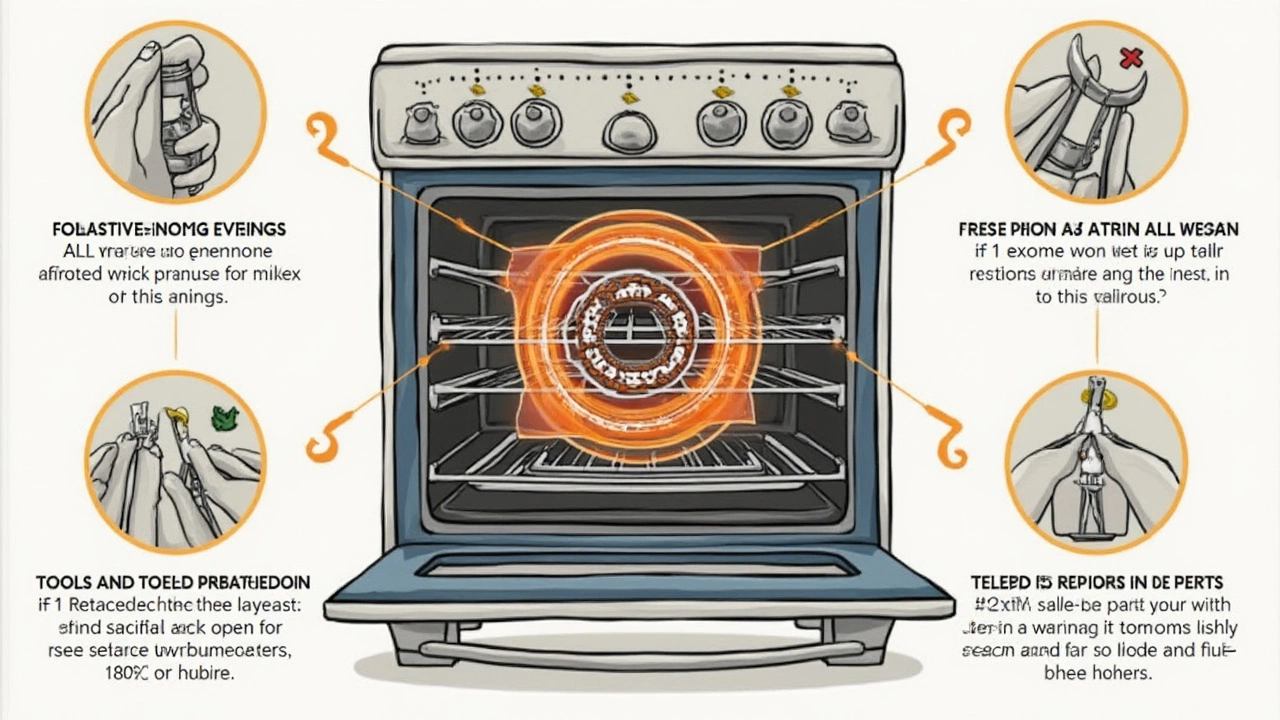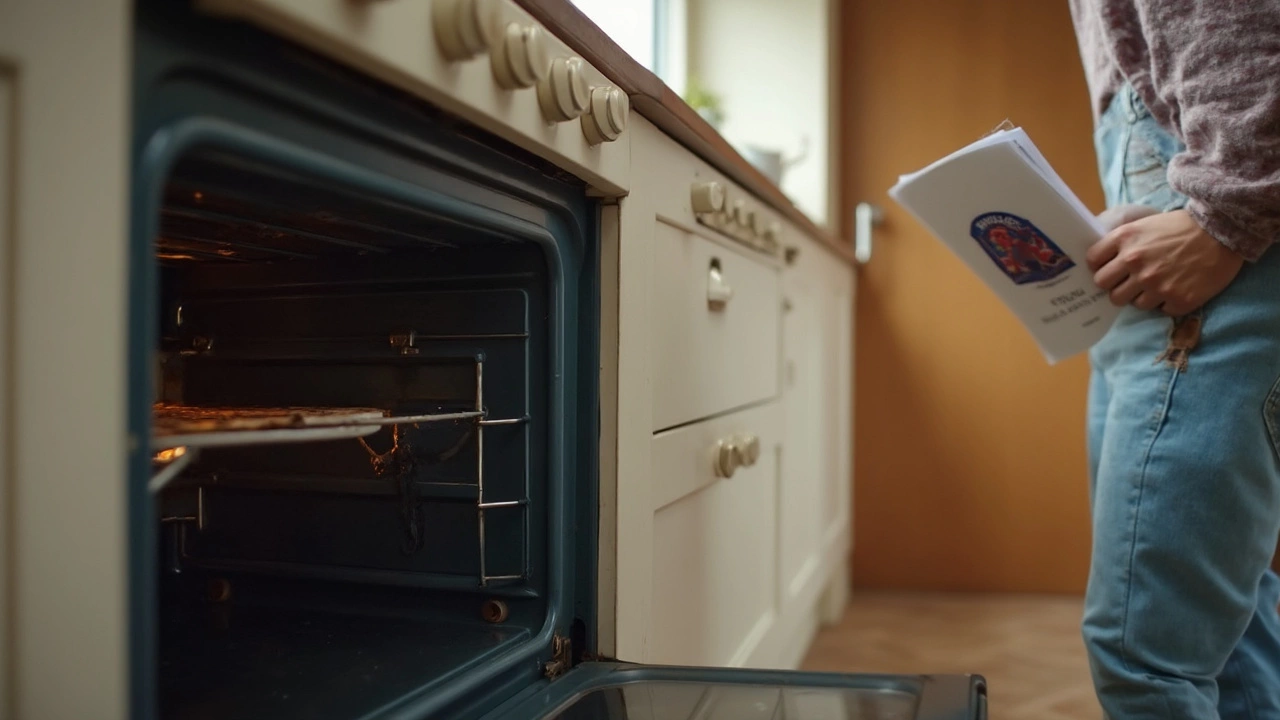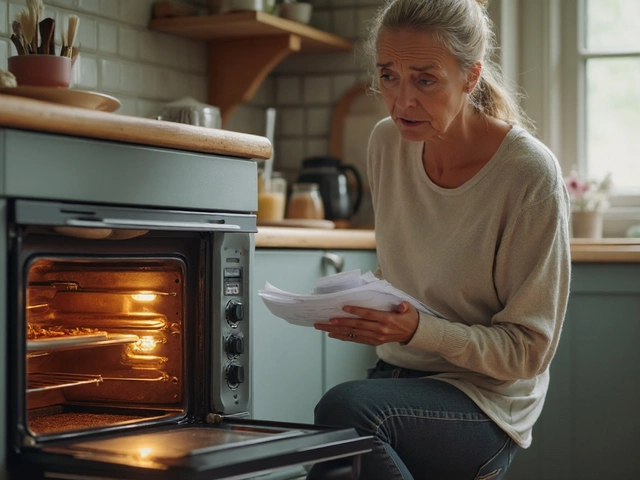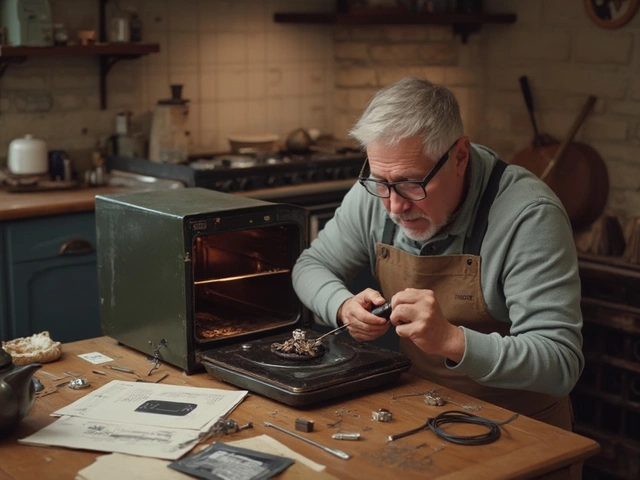Your oven’s heating element is basically the muscle behind every baked meal. If it’s not working, you’re left with some tough decisions. Most ovens have two main elements, one on the top for broiling and one on the bottom for general baking. If the bottom one is broken, baking is out, and if the top is dead, forget about a good broil.
Sometimes, people try to get by using the remaining working element. Want to warm a pizza with just the broiler? It’ll sort of work, but you have to babysit it—stuff burns quick or stays cold where you don’t want it. You won’t get that even, all-over heat your recipes need. And anything that needs slow, steady cooking—like lasagna or cakes—isn’t going to turn out right.
There’s also the safety angle. Broken heating elements can actually spark, short out, or arc. Ever see a glow bar with a chunk missing or a black burnt spot? That’s your sign to stop using it right now. You don’t want to risk an electrical fire just to make dinner.
- What Happens When an Oven Heating Element Breaks
- Is It Safe to Use the Oven Without a Working Element?
- What Can You Cook—And What Just Won’t Work
- How to Confirm the Heating Element Is the Problem
- Repair or Replace: The Most Practical Fixes
What Happens When an Oven Heating Element Breaks
When your oven heating element gives out, it’s not always a dramatic event—sometimes it just quietly stops putting out heat, and your dinner takes forever. On other days, you might hear a pop, see a quick flash, or even notice a nasty smell and a bit of smoke. The most obvious sign, though, is that your food just isn’t cooking right. Turn on your oven, set it to preheat, and if 10 or 15 minutes go by with nothing but cold air, the element’s cooked its last meal.
Electric ovens use either a hidden or visible metal coil. These coils are made from a special metal that gets red hot when electricity runs through. Over time, the repeated heating and cooling can crack the metal or burn it out, especially if there’s built-up grime or a food spill that’s been cooked onto it. A broken heating element can show burn marks, spots that look melted, or even spots where the metal has split.
Most home ovens have two elements: one for baking on the bottom and one for broiling up top. If the bake element breaks, you’ll notice the oven isn’t getting hot from below, so food will come out uneven (raw bottoms, burnt tops). If the broil element fails, nothing happens in broil mode or you get weird, patchy heating during any setting.
- No matter what, a dead heating element means your oven can’t keep a steady, even temperature.
- You might notice the oven keeps running constantly, trying to reach a temperature it’ll never achieve.
- An electric oven that runs with a faulty element can throw off error codes if it’s a newer model, or just quietly waste power in an older unit.
- Trying to keep using a oven repair candidate with a snapped coil can risk more than just ruined food—it can damage other oven parts.
Check your elements every now and then—sometimes you can spot a break before it ruins your family dinner. A flashlight can help you see cracks or blisters up close. The sooner you spot the problem, the faster you can get to fixing it—and get back to making meals that actually cook evenly.
Is It Safe to Use the Oven Without a Working Element?
Trying to cook with a busted heating element is risky business. If it’s completely shot, sometimes nothing happens—you turn it on, and all you get is disappointment. But the real trouble starts if it sort of works, has visible damage, or sparks when you switch it on. You might end up smelling burnt wires or even see small arcs of electricity. That’s more than just an inconvenience; that’s a fire waiting to happen.
According to a Consumer Product Safety Commission report, faulty or damaged oven elements are one of the top culprits in household appliance fires. If the element’s cracked, worn out, or has black scorch marks, the safest move is to switch off your oven at the breaker until it’s fixed.
“If you notice your electric oven’s heating element isn’t glowing fully or there are burn marks, do not keep using the oven. These signs signal potential electrical hazards,” says John Gannon, appliance repair expert for HomeEfficiencyGuides.com.
Some folks ask if leaving the oven on with only the broiler or lower element working is safe. The answer: maybe, for very short, supervised cycles if the dead element’s not physically damaged. But you might face uneven cooking and lots of frustration. You also lose your oven’s biggest safety feature: regulated, consistent heat. Here are the main risks when using an oven repair workaround:
- Electrical shorts can trip your breaker… or worse, start a fire.
- Surfaces around the dead element can overheat due to uneven heat distribution.
- Food cooks unpredictably, so you won’t get reliable results.
Here’s a quick rundown comparing oven issues and fire risk:
| Oven Condition | Safe for Use? | Fire Risk |
|---|---|---|
| Element not heating but intact | Only for broil, rarely | Low, but not zero |
| Element visibly damaged (cracked/burnt) | Never | High |
| Element sparks or arcs | Absolutely not | Very high |
Bottom line—if your oven’s element is toast, playing it safe means leaving it off until you can fix it. An oven isn’t worth risking your house or your family’s safety. If you need to cook, grab a countertop toaster oven or air fryer as a backup until you can handle the repair. That little bit of patience can go a long way.

What Can You Cook—And What Just Won’t Work
If your oven’s heating element is fried, you’re suddenly very limited when it comes to what you can actually make. The type of dishes you can cook depends on which element is gone—top, bottom, or both. Here’s what you need to know before you even think about cranking that dial.
When the bottom element fails (the main one for baking), you basically lose your ability to bake anything that needs steady, all-around heat. Foods like cookies, breads, casseroles, or pizzas won’t get cooked through. Cakes will come out half raw or dried out on top, and frozen meals might feel warm on the outside, but cold in the center. Broiling is still an option if your top element works, but that’s only good for thin foods and quick finishes.
- Broil-Only: Small portions of meat, melting cheese on toast, toasting breadcrumbs, reheating thin leftovers (if you keep an eye on them).
- Baking, roasting, and anything that needs bottom heat: No-go. Don’t try it—you’ll just ruin your food or waste electricity.
- Dual-element half-power: If you’re unlucky and only one side of a double coil is working, you’ll get unevenly cooked food—one half burned, one half underdone. Not worth the gamble for anything you actually want to eat.
If you’re tempted to risk it for a pizza or frozen dinner, here’s how the results stack up. This table lays out some common foods and how they fare with a busted heating element:
| Food | Top Element Only (Broil) | Bottom Element Only (Bake) |
|---|---|---|
| Frozen Pizza | Top burns fast, bottom stays soggy | Crust cooks, cheese doesn’t melt well |
| Chicken Breast | Can broil small cuts, but risk burning | Won’t brown on top |
| Cookies | Possible, but easy to scorch tops | Bakes ok if bottom works |
| Lasagna | Won’t cook through, top will dry out | Might warm up, but won’t bubble on top |
| Toast | Works for open-faced only | Won’t brown without top |
If you want to experiment, always stay in the kitchen. Set a timer for short intervals and check food often. But honestly, relying on a half-working oven is a hassle and rarely ends well. Better to use a toaster oven, air fryer, or microwave if you’ve got one handy.
How to Confirm the Heating Element Is the Problem
If your oven’s suddenly not heating right, you don’t have to immediately call in a pro. There are a few simple checks to see if the heating element is to blame. Start with the obvious: look inside your oven and check if the element glows red-hot when you turn the heat on. If it stays dark, that’s a big red flag.
Before sticking your hands in, make sure you turn the oven off and let it cool. Then check for these signs:
- Visible damage: Look for cracks, blisters, or even parts that seem melted or broken off.
- Burn marks: Dark or burnt spots on the element are a sure sign it’s toast.
- Uneven glow: If half of the element glows but the other half is dead, it’s on the way out.
If you have a multimeter—yeah, the little tool with two metal prongs—you can test the element for continuity. Set it to the lowest ohms setting. Yank the element out (just a couple of screws), unplug it, and touch the prongs to the element’s terminals. A reading between 10 and 50 ohms means it’s still working. No reading means you need a new one.
| Sign | What It Means |
|---|---|
| No glow when oven is on | Element isn’t heating at all |
| Cracks, bubbles, or splits | Physical damage, needs replacing |
| Dark burnt spots | Element is burnt out |
| Only part of element heats | Partial failure, uneven cooking |
| No continuity on multimeter | Element is dead |
Sometimes what looks like a busted element could just be a tripped circuit breaker, a blown thermal fuse, or even a fried control board. If everything checks out but your oven still isn’t heating, it’s worth a quick peek at the breaker box and thermostat connections. Still stumped? That’s when it makes sense to call in backup.

Repair or Replace: The Most Practical Fixes
Alright, let’s talk about fixing that busted heating element. Most people want to know: should you try to patch things up, or just swap the whole part? With an oven repair, there’s really no such thing as a true patch job if the element is cracked or completely dead. You’re almost always better off replacing the element altogether. Good news: it’s cheaper and simpler than you think.
According to the U.S. Department of Energy, "A heating element for a standard electric oven typically costs between $20 and $40, and with basic tools, most owners can install it themselves in less than 30 minutes."
“Replacing a faulty heating element is one of the most straightforward appliance repairs you can do at home, and often restores full oven function right away,” says Consumer Reports.
Here’s what you really need to know:
- Check your model number first. Your oven’s make and model are usually found on a sticker around the door or on the frame. You’ll need this for finding an exact replacement element.
- Unplug the oven before starting. Yes, it sounds obvious, but lots of folks skip this. You’re dealing with high-voltage wires.
- Access the element. Typically, you’ll remove a couple of screws inside the oven that hold the element in place. Gently pull the element forward to expose the wiring at the back.
- Disconnect and swap. The element usually connects with simple slide-on wires. Snap the new one in, screw it back down, and you’re set.
If you’re not comfortable with this, a local appliance tech will do it for about $100–$200 including parts and labor.
It actually pays to fix it yourself if you can. Here’s a quick look at the cost breakdown:
| Solution | Estimated Cost (USD) | DIY Skill Level |
|---|---|---|
| Buy and install element yourself | $20–$40 | Beginner |
| Pay a pro for replacement | $100–$200 | Not needed |
| Buy a new oven | $500+ | Not needed |
Skip temporary fixes like foil or "creative wiring." Those tricks don’t last and can get downright dangerous. If your oven is under warranty, check first—some brands will send you the part for free or cover the repair.
Bottom line: if your oven’s heating element is on the fritz, repair isn’t just possible—it’s usually the smartest move, as long as you stick to these tried-and-true steps.




